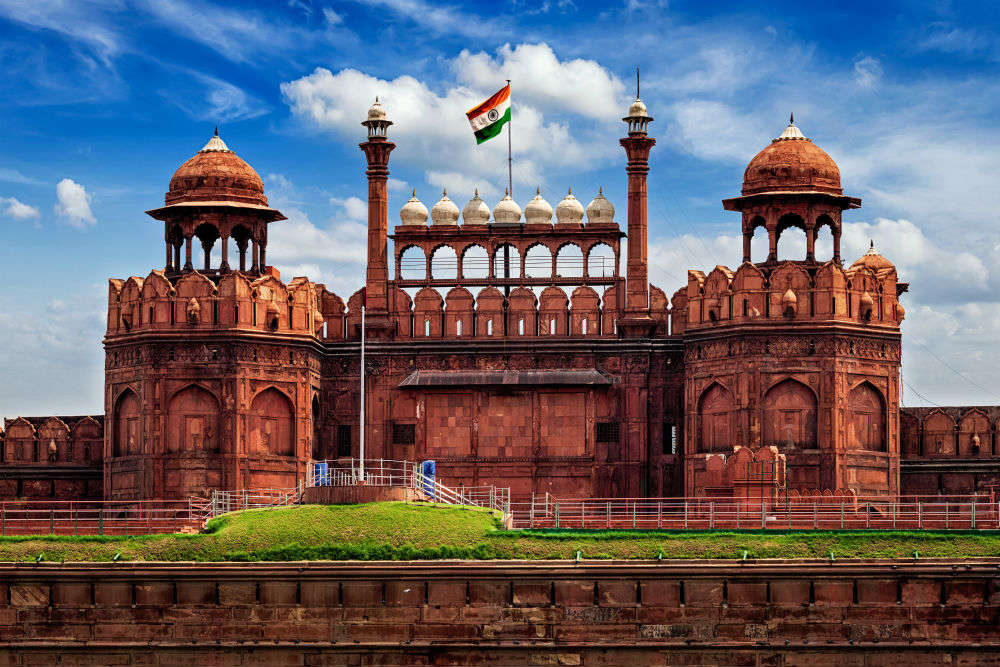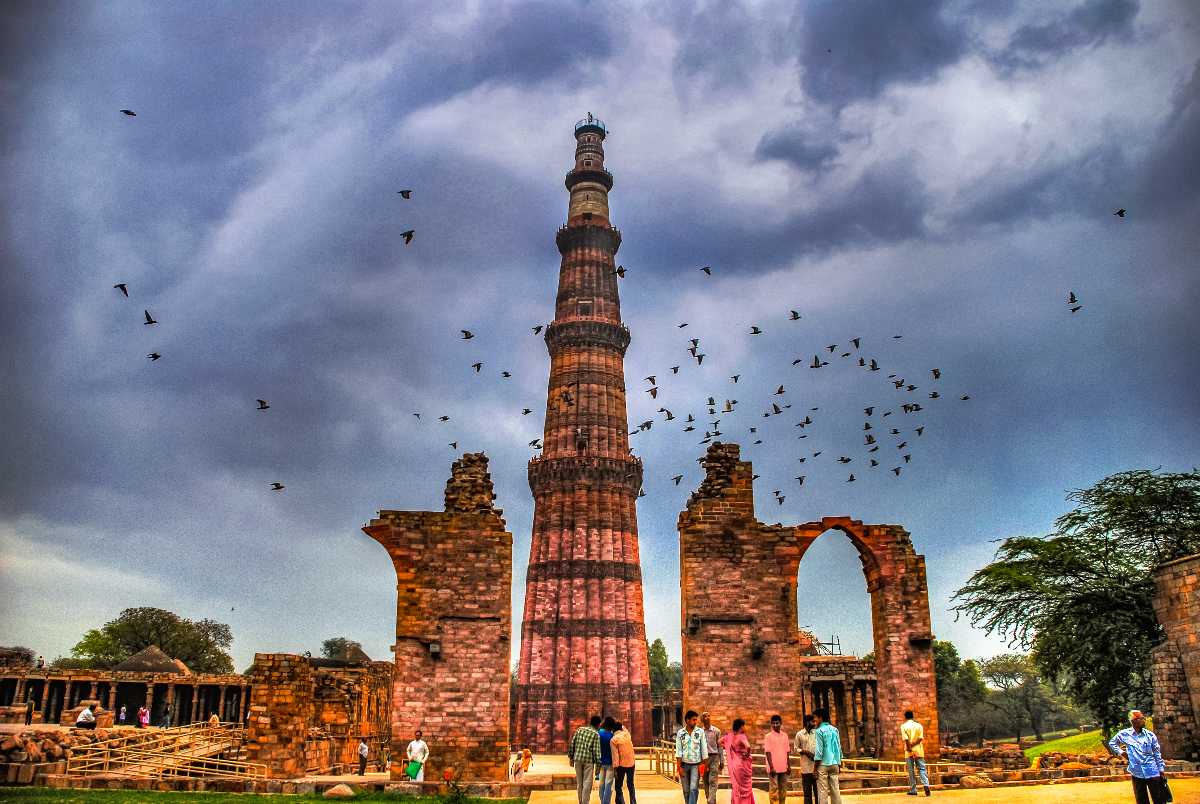Delhi
Visit Delhi
Red Fort
The Red sandstone walls of the massive Red Fort (Lal Qila) rise 33-m above the clamour of Old Delhi as a reminder of the magnificent power and pomp of the Mughal emperors. The walls, built in 1638, were designed to keep out invaders, now they mainly keep out the noise and confusion of the city. The main gate, Lahore Gate, is one of the emotional and symbolic focal points of the modern Indian nation and attracts a major crowd on each Independence Day. The vaulted arcade of Chatta Chowk, a bazaar selling tourist trinkets, leads into the huge fort compound. Inside is a veritable treasure trove of buildings, including the Drum House, the Hall of Public Audiences, the white marble Hall of Private Audiences, the Pearl Mosque, Royal Baths and Palace of Color. An evening sound and light show re-creates events in India's history connected with the fort.

Qutub Minar
Completed in the 12th century, the beautiful Qutub Minar is India's tallest minaret. It's also now a UNESCO Word Heritage Site that attracts many international visitors eager to climb to the top for its breathtaking views of the surrounding area. This ornate five-story tower rises more than 70 meters and is covered with intricate carvings featuring the history of Qutub along with inscriptions from the Koran. It's also notable for being constructed of a number of different types of stone (the first three stories are made of red sandstone, while the fourth and fifth stories were built with marble and sandstone). The complex also includes the Quwwat-ul-Islam Masjid, a mosque at the base of the tower; a gateway built in 1310; and the tombs of Altamish, Alauddin Khalji, and Imam Zamin. Also worth seeing is the 2,000-year-old Iron Pillar, the Alai Minar.

India Gate
Looking a little like the famous Arc de Triomphe in Paris, the equally impressive India Gate is a ma flame burns beneath the massive structure, and its walls are inscribed with the names of more than 90,000 soldiers who died in the conflict. Standing on a base of red stone and featuring a shallow domed bowl on top that is occasionally filled with burning oil (usually only on important anniversaries), the structure dominates the parkland around it, an always busy area with crowds of tourists and locals alike enjoying a picnic or simply relaxing. For a real treat, try to see the India Gate at night, considered one of the top free things to do in New Delhi. It's a spectacular sight when it and nearby fountains are floodlit.

Jama Masjid
The Jama Masjid is one of India's largest mosques and was the final architectural feat of Shah Jahan. Completed in 1658, this beautiful structure features three gateways, four angled towers, and two 40-meter-high minarets built using red sandstone and white marble and attractively alternated in vertical stripes. Visitors can climb to the top of the southern minaret for spectacular views of Old Delhi, and afterwards visit the large central pool used for washing before prayers. Please note: visitors must take off their shoes and be appropriately dressed before entering; non-Muslims aren't permitted during prayers. Afterwards, be sure to visit Chandni Chowk, Old Delhi's massive main thoroughfare and a market area dedicated to shopping and eating. Of particular interest are Naya Bazaar and Gadodial, famous spice markets where you'll see hundreds of items displayed including aniseed, ginger, pomegranate, saffron, lotus seeds, pickles, and chutneys.

The Lotus Temple
The magnificent Bahá'í House of Worship, also known as the Lotus Temple due to its nine sides and stunning central dome, is an architectural masterpiece. Constructed of white concrete and marble, the entire structure looks as delicate as the flower it resembles. Rising from the surrounding nine pools of water, it almost appears as if it might burst into bloom at any moment. Built in 1986, the temple has since attracted more than 70 million visitors, making it one of the world's most visited attractions. Interestingly, this remarkable place of worship has no idols, religious pictures, or outward symbols of religion. Another modern day temple worthy of a visit is the ISKCON Temple, one of the country's biggest Krishna temple complexes.

Rajpath and Rashtrapati Bhavan
Rajpath, also known as the King's Way, is New Delhi's traditional ceremonial boulevard. It runs from Rashtrapati Bhavan, the official presidential residence, past such important city landmarks as Vijay Chowk and India Gate all the way to the National Stadium. This broad avenue is flanked by trees, grass, and ponds, and comes alive each January 26th during the Republic Day Parade. This special occasion is marked by countless thousands gathering to celebrate the anniversary of the country's independence. At the western end of Rajpath, the President's Residence-the Rashtrapati Bhavan (once the British Viceroy's residence)-is undoubtedly one of the most magnificent buildings in Delhi. It's an attractive place for a selfie given its eclectic mix of Mughal and European architectural styles that contains some 340 richly decorated rooms. Of particular interest is the new Rashtrapati Bhavan Museum, which offers a glimpse inside the building, along with interesting displays relating to past presidents. Hot Tip: If visiting in February or March, check out the adjoining Mughal Gardens, a splendid display of plantings surrounding the President's Residence.

The Culture of Delhi
Delhi is the traditional and present day capital of India. Delhi stands in a triangle formed by the river Yamuna in the east and spurs from the Aravali range in the west and south. Delhi is not only the largest commercial centre in Northern India, but also the largest centre of small industries. The IT sector, handloom, fashion, textile and electronic industry contribute a lot to Delhi's economy. Delhi is bounded by four states namely Haryana, Rajasthan, Uttar Pradesh and Punjab that have a strong influence on the lifestyle of Delhi. Delhi is a cosmopolitan city where people are open to embracing new ideas and life style. People from all parts of the country live here. Alll major festival of Inida are celebrated and the Unity in Diversity is evident in social and cultural gatherings. Be it Holi, Diwali, Id, Guru Purab, Buddha Purnima or Christmas, you will find the same vigor and bliss among people from different communities.

The Most Popular Dishes in Delhi
The capital’s love for food can take you from small unknown streets to well-known restaurants, but there are some popular dishes in Delhi that are found everywhere. From pocket-friendly variations of
these famous food options to splurging in fine dining hall posh portions, Delhi’s romance with these dishes doesn’t discriminate. If you are in love with all things delicious, you would share Delhi’s
love for these dishes as well.
The capital’s love for food can take you from small unknown streets to well-known restaurants, but there are some popular dishes in Delhi that are found everywhere. From pocket-friendly variations of
these famous food options to splurging in fine dining hall posh portions, Delhi’s romance with these dishes doesn’t discriminate. If you are in love with all things delicious, you would share Delhi’s
love for these dishes as well.
• Chole Bhature: All Time Favourite
• Golgappe: King of Chaats
• Poori Aloo: Indulge in the Goodness of Spices
• Dahi Bhalle: Perfect Blend of Sweet and Tangy
